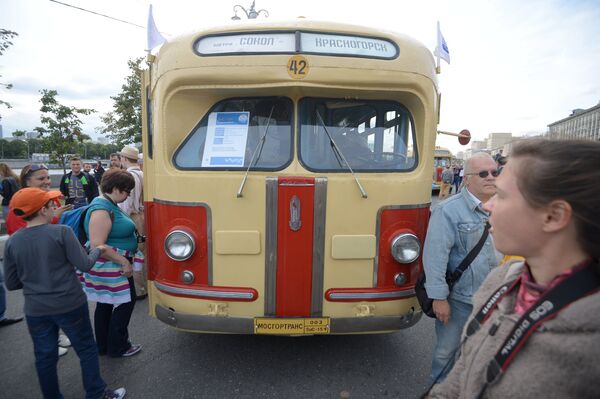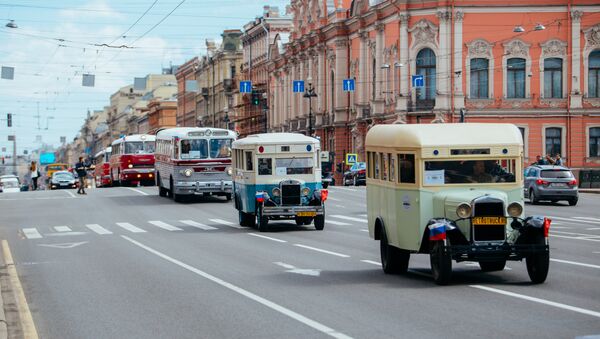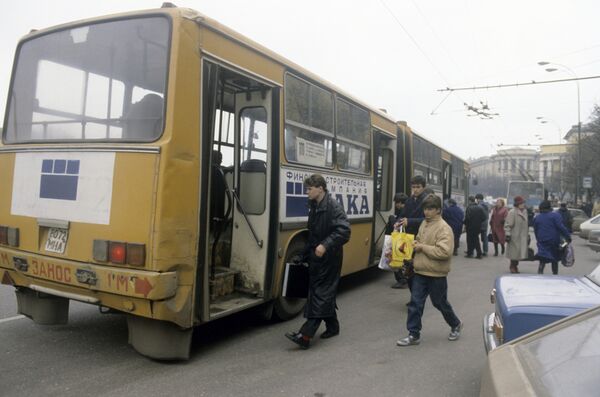This weekend, on the occasion of the 90th anniversary of the start of regular bus service in St. Petersburg, residents and guests of Russia's northern capital got a chance to see a unique exhibition of retro-buses and trolleys. Organized by Passengeravtotrans – St. Petersburg's public bus transport provider, and the St. Petersburg State Museum of History, the event was filled with examples of rare buses, each lovingly restored by specialists.
In the spirit of the celebration, Izvestia writer Evgenia Priemskaya decided to take a look back at some of the most iconic buses of the Soviet period, as well as some rare and interesting designs which never made it to mass production.
AKZ-1: The First Bus of the Early Postwar Period
Beginning in the difficult period of reconstruction after World War II, Priemskaya recalled that the production of new buses became an important symbol of the return of peaceful life. During the war, most buses were sent to the front, many of them destroyed, damaged beyond repair, or converted for military use.
"The AKZ-1 came to help save the situation," Priemskaya wrote. "This bus was assembled from wooden planks at the AremKuZ repair factory, paneled with sheet metal and put on the chassis used by ZiS-150 trucks. Often, the buses included components from other vehicles which could not be restored."

"The first AKZ-1 was released in 1947, appearing just in time for Moscow's 800th anniversary. However, these buses' no-frills nature was also their downside. The wooden structures proved short-lived, and soon most of the buses would be scrapped. A total of about 80 AKZ-1s were produced."
ZiS-154: Comfortable and Stylish
The ZiS-154 would come to enjoy fame as the first truly mass-produced bus of the post-war period. More importantly, passengers appreciated the bus for its revolutionary design, and its comfort.

Priemskaya writes: "The ZiS-154's round headlights and rounded-off cabin would subsequently be shared with the MTB-82 trolleybus, and the MTB-82 tram. This model would be the first time that the domestic auto industry produced an all-metal body. Passengers fell in love with it first and foremost for its comfort. Unlike pre-war models, the bus was equipped with a spring suspension, had a wide doorway, illumination…and most importantly, a ventilation system."
Ease of operation and driver comfort was another innovation of the ZiS-154.
The first ZiS-154 rolled off the conveyor belt in 1946, with production growing steadily into the early 50s. 1,185 units were produced, some of them equipped with improved engines, which allowed them to continue operating until the late 1960s.
KAvZ-52 Ritsa: Rare Sight in European Russia
The KAvZ-52 Ritsa, developed in the early 1950s, featured one very unique design feature: an open cabin. Designed specifically for excursion work in resort areas, the unique bus featured a tarp that could be put over the cabin in case of bad weather. Named after Abkhazia's Lake Ritsa, the KAvZ-52 could comfortably accommodate about 20 people, plus the driver and tour guide.

KAvZ-663: Science Bus
Built on the basis of a KAvZ-651A, the KAvZ-663 was another unique design in that unlike the majority of its people-transporting cousins, it was never meant to transport passengers. Instead, it was used as a mobile seismic station, which Soviet scientists would use in hard-to-reach areas in the country.

The bus had fewer windows, didn't have the traditional interior bench seating, and featured a blind partition between the cabin and the driver's seat. Most importantly, it was fitted with all-wheel drive to make it capable of driving through those hard to reach places far away from civilization. The first KAvZ-663 was produced in 1961, with 52 more to follow. Field work ultimately showed that the bus's off-roading capabilities were insufficient for scientists' needs, and the KAvZ-663 was withdrawn from production.
LiAZ-667: The Legend
Priemskaya wrote that "without a doubt, the LiAZ-677 takes the title of the mass-produced Soviet bus." The first bus of the series was created in 1963, mass production began in 1967, and was so popular that limited production by third parties would continue all the way into the early 2000s.
In total, about 194,000 LiAZ-677s of varying modifications were produced, with the bus receiving several styling makeovers over its production run.
These buses could be met literally in every corner of the Soviet Union, used on both city and suburban routes, and eventually became a Soviet icon. They gained popularity for being spacious, for their smooth ride, and for good heating systems during the cold winter months. Among their downsides were poor fuel economy and a tendency to overheat in the summer months. The bus remains a powerful source of nostalgia for many people, with nearly two dozen cities across the former USSR setting up monuments in its honor.
LAZ-695
Among its unique features, the LAZ-695 'Festivalny' featured windows on its roof. Produced by the Lviv Bus Factory in western Ukraine, these vehicles became extremely popular among tourists, and for long excursions in the countryside.

Other novelties for the LAZ-695 was that it was the first bus in Soviet automotive history featuring a rear overhang mounted engine.
In addition to its innovative design, the LAZ-695 enjoys the status of being another of the most popular buses in Soviet automotive history, with 40,000 units of the LAZ-695E produced between 1963 and 1970. That model featured an improved 150 hp engine, improved transmission and upgrade brakes. The LAZ-695H and NG, featuring new body style, new instrument cluster, and a series of comfort and safety innovations, would continue production until the mid-2000s.
Ikarus 280
The Ikarus 280, an articulated bus design produced in Hungary at the Ikarus Bus Factory in Szekesfehervar, takes the award for being the most widely imported foreign bus in Soviet history, according to Priemskaya.
Among the Ikarus 280's many advantages was its spaciousness, ensured by its articulated design. Passengers and drivers also appreciated the comfortable ride, soft suspension, good adaptability to difficult climatic conditions, comfortable interior layout, and large windows. In the 70s and 80s, the legendary bus, painted a standard yellow for Soviet export, could be found in all regions of the country, from the Far East to the Baltic republics.
Ikarus stopped production of the 280 for domestic use in 1993, but continued exports into the former Soviet Union, albiet at dramatically reduced levels, the last bus of the series coming off the production line in 2002.
Visit Izvestia's page to see 3D views of the interiors of each of these buses.





